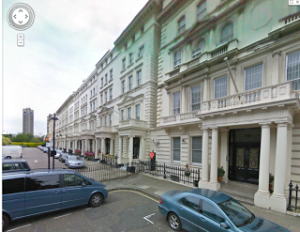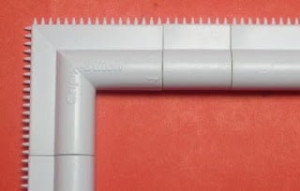Are you curious about what it was like to be student at RSN? I would be if I had not had the good fortune and an accommodating father to pay the bill. Actually, I remain curious to hear about being a student at Hampton Court Palace and hope others with more recent experience will add to this account.
You can Google this address but, for those not familiar with London, Prince’s Gate is a terrace off Kensington Road. Crossing the road to the north is Hyde Park with the Serpentine and Rotten Row, a horse and carriage riding route. Connecting Kensington Road to the south is Exhibition Road which leads to South Kensington Underground station. The Victoria and Albert Museum, the Natural History Museum and the Science Museum are all located on Exhibition Road. To the west, you will find the Royal Albert Hall, Imperial College and Kensington Palace, the home of several members of the Royal family. Going east will take you to Knightsbridge and Harrods. I found the history of the development of this area of London to be interesting and hope that you will, too.
In the late 1600s, a gardener named George London and partners established the Brompton Park Nurseries, part of which is now the site of the Victoria and Albert Museum. Influential in garden design and innovative plantings, he nurtured plants and trees brought to him by travellers to other countries. He supplied plants and trees and landscape designs in London, elsewhere in England and in Europe. In the 1700s the neighbouring rural village of Brompton experienced a building boom with an influx of terraced houses and the creation of a busy metropolitan borough. A further building boom in the early 1800s transformed the area into a prosperous residential area. Portions of the nursery garden were appropriated for building.
All this is linked to the Industrial Revolution (1760-1870). Water and steam power and the development of machine tools influenced every aspect of daily life in Britain. Massive population and income growth created the first capitalist economy leading to both great wealth and abject poverty. Steam-powered ships and railways were late developments of the Industrial Revolution
In 1850, Britain decided to celebrate its huge achievement with a Grand Exhibition. The contract was awarded to Joseph Paxton who built a modular style building of cast iron and glass and erected it in the southern part of Hyde Park. Punch, the magazine, dubbed it the Crystal Palace. With so much glass, it needed no electric lighting system but the glass panelling was not watertight and there were widespread leaks in the roof. After the Exhibition closed the Crystal Palace was dismantled and rebuilt in south London where it survived until destroyed by fire in 1936.
Britain had money to spend and Prince Albert, Queen Victoria’s husband, proposed that the area south of Hyde Park be developed as an area for enrichment and education. Thus began the founding and building of Exhibition Road, the museums and the Royal Albert Hall. He died in 1861 before seeing the completion of these projects. The Albert Memorial was built in Hyde Park opposite the Royal Albert Hall and commemorates his contribution. Queen Victoria was devastated by his death and went into mourning for the rest of her life.
To move back to Prince’s Gate, this area just north of the original Brompton Park Nursery was a market garden growing vegetables and fruit to supply the London area. In the early 1800s, plans were drawn up for a four sided block of rental town houses enclosing a private and ornamental garden. Of necessity, the first buildings were stables and a carriage house. Prince’s Gate faces onto a carriage way. This private road was set apart from the the main road and allowed horses and carriages safe access to the front doors of the houses. It is now a convenient place to park your car. Speculative building of houses with four to five storeys over a basement began in the 1840s. This was a large project and took several years to complete. The houses were slow to rent initially and then fell out of favour during the building and use of the Crystal Palace as prospective tenants complained of the loss of their view of Hyde Park and all the traffic and noise created by the Grand Exhibition. NIMBY is nothing new! Gradually, the houses were occupied by the newly rich bankers, industrialists, ship owners and minor aristocracy who wanted smart and convenient town houses in this new and fashionable area of Kensington. Despite interior differences, the facades were similar and Italianate, three windows wide with a porticoed entrance on the ground floor. The stuccoed exteriors were painted white and remain white to this day as you will see in the photograph.

Royal School of Needlework
The photo is courtesy of Google Street View and is current; in the 1950s, there were far fewer cars. No. 25 is the first house and entrance beyond the black railing. It is a bit larger than was normal as it is L shaped taking advantage of an indentation in the previously built house on the right of the photo; that building is now a boys’ school. No. 25 was occupied by The Royal School of Needlework from 1949 to 1987 when RSN moved to Hampton Court Palace. In the 1990s the whole house was refurbished and restored to a single residence. This area of London is now the location of foreign embassies with several located in Prince’s Gate.
British History Online www.british-history.ac.uk provided the information for this précis. Of further interest to stitchers are the designs for the floor and ceilings of these houses to be seen on the British history sites.
Having taken you on a historical tour, my next entry will be about being a student of RSN in this historic house during a time, just five years after the end of WW 2, when London was still bleak and dirty and food was short. But we survived and the RSN experience was certainly an interesting one.








































